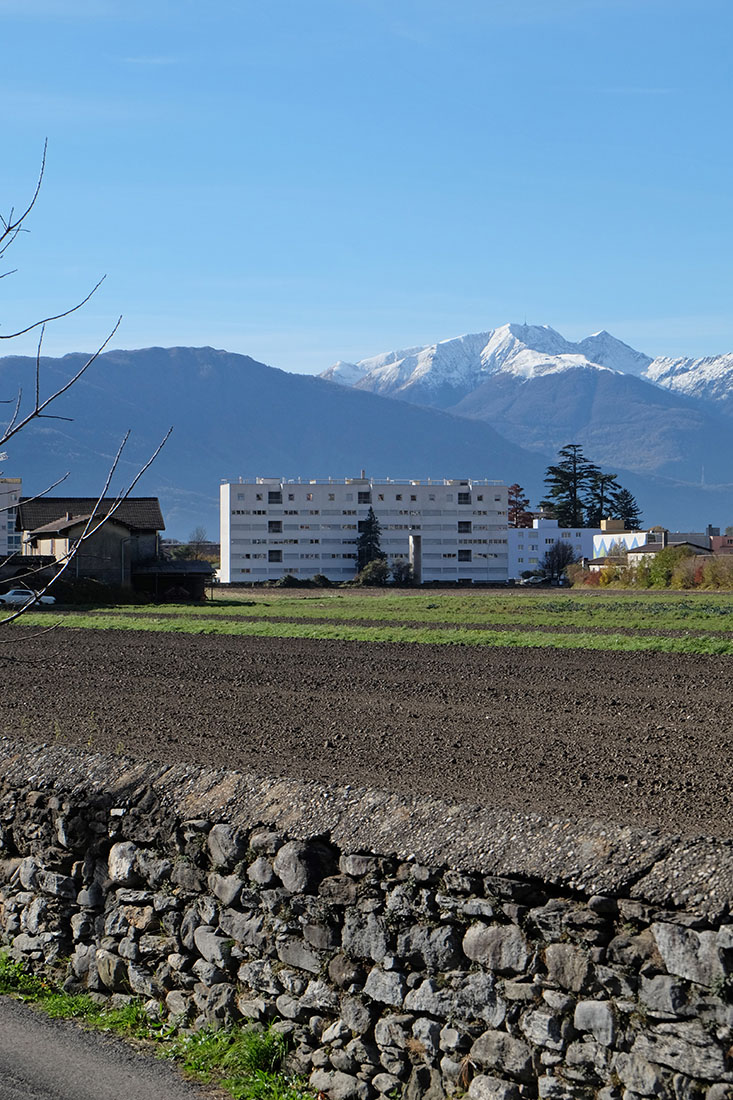 |
 |
 |
 |

Case d'Appartamenti
Via Prato Carasso 7, Via Vallone, Bellinzona
1971 - 1972
The two apartment buildings by Roberto Bianconi
on Via Prato Carasso and Via Vallone in Bellinzona are among the most
notable in the canton of Ticino. The two buildings from the years
1971/72 are located at the transition between city and countryside,
with farmland and sports fields on the north side. In this difficult
context, which actually lacks urban qualities, the strength of the
project lies in the reaction to the two different environments.
Accordingly, the two different sides of the building, facing the street
or the garden are, are strongly differentiated. The north-facing street
facade appears flat, and is dominated by band windows, behind which are
the bedrooms. The southern side, on the other hand, is strongly
rhythmised by the projecting components and characterized by the
eye-catching glass finishes of the balconies and the large windows. The
vertical bodies with the balconies and loggias refer to the Bauhaus
style and the modernist machine aesthetics. This facade opens to the
vast and bright landscape in the south, with the castles over the
historic center and Lake Maggiore on the horizon. Together, the two
residential buildings form a unit that to be read as an answer to the
banality of the suburbs. In particular, the floor plans are convincing.
Despite the small dimensions they feature great spatial qualities. On
the reduced floor area, which had to comply with the guidelines for
social housing, Bianconi organizes a clear floor plan with some special
features. The apartment is accessed via a small entree, the bedrooms
are oriented to the north and the day rooms open to the beautiful and
sunny side. Particularly surprising are the laterally glazed balconies,
which are incorporated into the floor plan. The careful and ingenious
articulation of living, eating, cooking and balcony is the real wealth
of small apartments. An additional subtlety is the connection between
the living room and master bedroom. The design of the interiors can not
be reduced to individual aspects, but is developed in close interaction
with the exterior appearance of the buildings.
Die beiden Mehrfamilienhäuser von Roberto Bianconi an der Via Prato Carasso und der Via Vallone in Bellinzona gehören zu den bemerkenswertesten im Kanton Tessin. Die beiden Gebäude aus den Jahren 1971/72 befinden sich an der Schnittstelle zwischen Stadt und Land, mit Ackerland und Sportfeldern auf der Nordseite. In diesem schwierigen Kontext, welchem der eigentliche städtische Raum fehlt, liegt die Stärke des Projektes in der Reaktion auf die beiden unterschiedlichen Umgebungen. Entsprechend zeigen sich die beiden Gebäude zur Strasse respektive zum Garten stark differenziert. Die nordseitige Strassenfassade erscheint flach, und wird von Bandfenstern domiiniert, hinter welchen sich die Schlafzimmer befinden. Die Südseite wird hingegen durch die vorspringenden Bauteile stark rhythmisiert und von den auffälligen Glasabschlüssen der Balkone sowie den grossen Fenstern geprägt. Die vertikalen Körper mit den Balkonen und Loggien verweist auf das neue Bauen und die modernistische Maschinenästhetik. Diese Fassade öffnet sich zur weiten und hellen Landschaft im Süden, mit den Burgen über dem historischen Zentrum und dem Lago Maggiore am Horizont. Zusammen bilden die beiden Wohnhäuser eine Einheit, welche in der Gestaltung auf die Banalität der Vorstadt reagiert. Insbesondere überzeugen die Wohnungsgrundrisse, welche trotz der geringen Ausmasse grosse räumliche Qualitäten aufweisen. Auf der reduzierten Fläche, welchen den Richtlinien für Sozialwohnungen entsprechen musste, organisiert Bianconi eine klaren Grundriss mit einigen Besonderheiten. Die Wohnung betritt man über ein kleines Entrée, nach Norden orientieren sich die Schlafzimmer und zur schönen und sonnigen Seite öffnen sich die Tagesräume. Zu überraschen vermögen insbesondere die seitlich verglasten Balkone, welche in die Grundrissgestaltung einbezogen wurden. Die sorgfältige und erfindungsreiche Artikulation von Wohnen, Essen, Kochen und Balkon ist der eigentliche Reichtum der kleinen Wohnungen. Eine zusätzliche Feinheit ist die Verbindung zwischen dem Wohn- und Elternschlafzimmer. Die Gestaltung der Innenräume lässt sich aber nicht auf einzelne Aspekte reduzieren, sondern steht in einer engen Wechselwirkung zur äusseren Erscheinung der Bauten.
Die beiden Mehrfamilienhäuser von Roberto Bianconi an der Via Prato Carasso und der Via Vallone in Bellinzona gehören zu den bemerkenswertesten im Kanton Tessin. Die beiden Gebäude aus den Jahren 1971/72 befinden sich an der Schnittstelle zwischen Stadt und Land, mit Ackerland und Sportfeldern auf der Nordseite. In diesem schwierigen Kontext, welchem der eigentliche städtische Raum fehlt, liegt die Stärke des Projektes in der Reaktion auf die beiden unterschiedlichen Umgebungen. Entsprechend zeigen sich die beiden Gebäude zur Strasse respektive zum Garten stark differenziert. Die nordseitige Strassenfassade erscheint flach, und wird von Bandfenstern domiiniert, hinter welchen sich die Schlafzimmer befinden. Die Südseite wird hingegen durch die vorspringenden Bauteile stark rhythmisiert und von den auffälligen Glasabschlüssen der Balkone sowie den grossen Fenstern geprägt. Die vertikalen Körper mit den Balkonen und Loggien verweist auf das neue Bauen und die modernistische Maschinenästhetik. Diese Fassade öffnet sich zur weiten und hellen Landschaft im Süden, mit den Burgen über dem historischen Zentrum und dem Lago Maggiore am Horizont. Zusammen bilden die beiden Wohnhäuser eine Einheit, welche in der Gestaltung auf die Banalität der Vorstadt reagiert. Insbesondere überzeugen die Wohnungsgrundrisse, welche trotz der geringen Ausmasse grosse räumliche Qualitäten aufweisen. Auf der reduzierten Fläche, welchen den Richtlinien für Sozialwohnungen entsprechen musste, organisiert Bianconi eine klaren Grundriss mit einigen Besonderheiten. Die Wohnung betritt man über ein kleines Entrée, nach Norden orientieren sich die Schlafzimmer und zur schönen und sonnigen Seite öffnen sich die Tagesräume. Zu überraschen vermögen insbesondere die seitlich verglasten Balkone, welche in die Grundrissgestaltung einbezogen wurden. Die sorgfältige und erfindungsreiche Artikulation von Wohnen, Essen, Kochen und Balkon ist der eigentliche Reichtum der kleinen Wohnungen. Eine zusätzliche Feinheit ist die Verbindung zwischen dem Wohn- und Elternschlafzimmer. Die Gestaltung der Innenräume lässt sich aber nicht auf einzelne Aspekte reduzieren, sondern steht in einer engen Wechselwirkung zur äusseren Erscheinung der Bauten.
